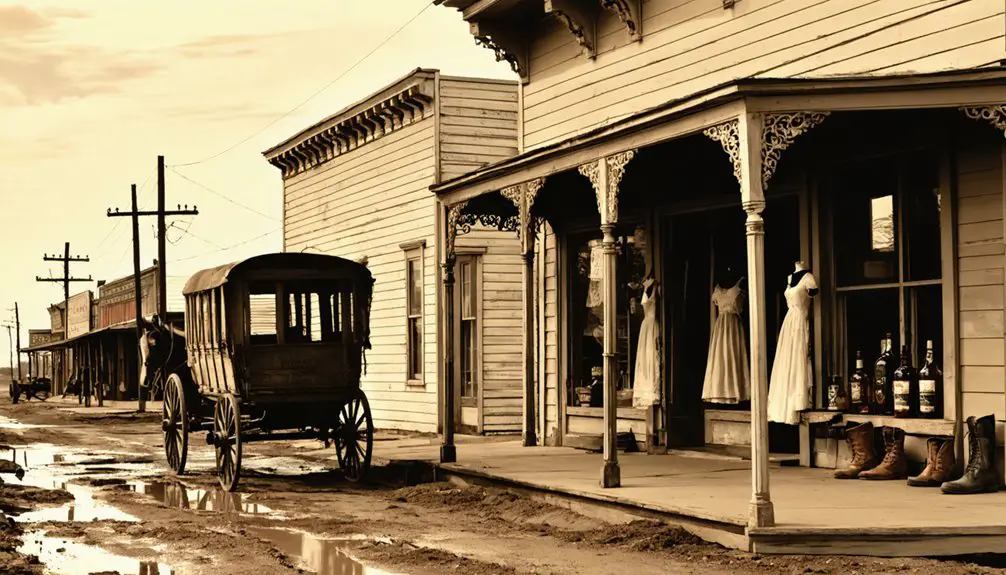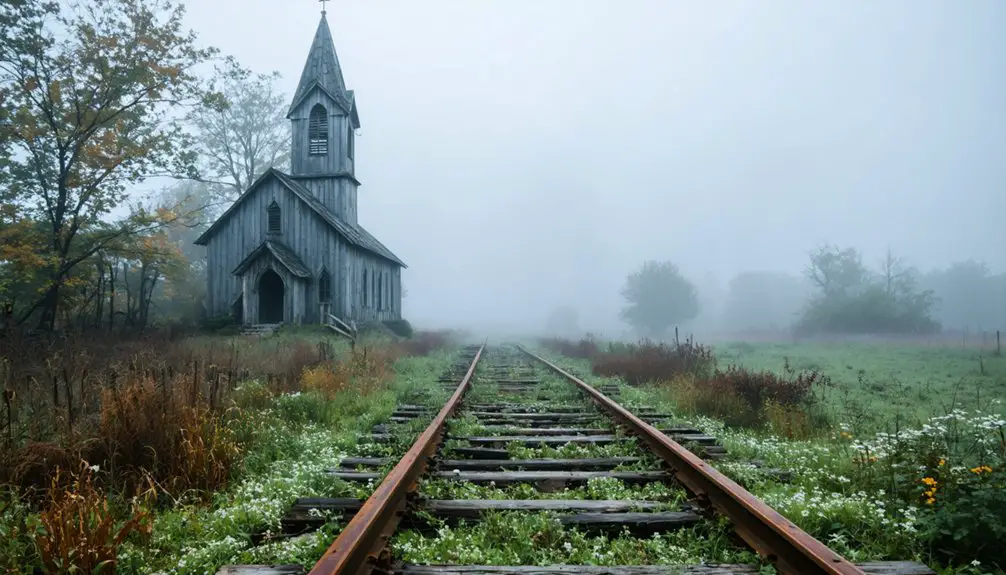You’ll find Bingham ghost town in Michigan’s Leelanau County at 44°55′13″N, 85°39′59″W, along the West Arm of Grand Traverse Bay. Established in 1864, this former logging settlement thrived with its sawmill (built 1881) and post office (opened 1878) until shifting transportation routes bypassed the town. Named after Michigan’s first Republican governor Kinsley Scott Bingham, the abandoned site now lies hidden beneath dense vegetation, holding stories of pioneer life and economic transformation in 19th-century Michigan.
Key Takeaways
- Bingham Township was established in 1864 in Leelanau County, Michigan, initially thriving due to abundant timber resources and sawmill operations.
- The settlement declined after being bypassed by railroad lines, which shifted agricultural shipping and trade to better-connected neighboring towns.
- Located at coordinates 44°55′13″N, 85°39′59″W along Grand Traverse Bay, the ghost town site sits at 725 feet elevation.
- Dense vegetation has reclaimed the abandoned town site, making foundation ruins most visible during early spring or late fall.
- The town was named after Kinsley Scott Bingham, Michigan’s first Republican governor who served from 1855 to 1859.
Origins of the Settlement
While Michigan’s rural development flourished in the mid-1800s, Bingham Township emerged in 1864 when it split from Centerville Township in Leelanau County. Mining was also transforming Michigan’s landscape, with the nation’s first copper boom beginning in 1844.
Following typical settlement patterns of the era, pioneers were drawn to the area’s abundant timber resources, establishing a community that would soon gain recognition with the opening of a post office in 1878.
Similar to the development of Kensington that used the Grand River Indian Trail, early transportation routes were crucial for the growth of frontier communities.
You’ll find that early industries centered on logging, with a sawmill constructed in 1881 becoming the backbone of the local economy.
The settlement’s growth mirrored the broader migration trends seen across Michigan during this period, as settlers from New York and other eastern states ventured west in search of opportunity.
Like many Michigan communities of its time, Bingham’s founding was part of the westward expansion that followed the Erie Canal’s completion.
The Legacy of Kinsley Scott Bingham
You’ll find Kinsley Scott Bingham‘s influence on Michigan reflected in the three townships bearing his name across Clinton, Huron, and Leelanau counties, marking his significance as the state’s first Republican governor from 1855 to 1859.
Before establishing himself in state politics, Bingham settled in Green Oak Township in 1833, where he would later spend his final days.
As a pioneer in both agriculture and politics, Bingham’s leadership established Michigan State University and championed essential educational reforms while serving as U.S. Representative and later Senator.
In 1855, he oversaw the completion of the St. Mary’s Canal, a crucial project that enhanced commerce throughout the Great Lakes region.
His death in office in 1861 left a lasting legacy in the region, evident through his contributions to Michigan’s political realignment and the development of its educational institutions.
Political Rise in Michigan
As Michigan’s political landscape evolved in the mid-1800s, Kinsley Scott Bingham emerged as a transformative figure who shaped the state’s early Republican movement. His political influence began at the local level in Green Oak Township, where he served as postmaster and justice of the peace before ascending to the Michigan House of Representatives in 1837.
After establishing his law practice in Michigan, Bingham quickly became involved in local politics and public service. A graduate of Hamilton College, he brought strong educational credentials to his political career.
Bingham’s governance strategies proved effective as he served three terms as Speaker of the House before winning election as Michigan’s first Republican governor in 1854.
You’ll find his impact in the creation of Michigan State University, then called the Agricultural College of the State of Michigan, and the establishment of the State Reform School.
His leadership culminated in his 1858 election to the U.S. Senate, where he served until his death in 1861.
Pioneer Spirit and Leadership
Despite his humble beginnings in Camillus, New York in 1808, Kinsley Scott Bingham’s pioneering spirit and leadership would transform Michigan’s early development.
As one of Michigan’s first Republican governors, he embodied the pioneer heritage that shaped the state’s character during a critical period of growth. Having served as Speaker for three years, he gained valuable legislative experience before his governorship.
His dedication to community resilience manifested through:
- Founding the Agricultural College of the State of Michigan (now MSU) to empower farmers with formal education
- Establishing the State Reform School to rehabilitate troubled youth
- Creating multiple new counties and villages while overseeing essential infrastructure projects like the St. Mary’s Falls ship canal
You’ll find his lasting impact in the multiple Michigan townships bearing his name, and his final resting place in Brighton’s Old Village Cemetery stands as a reflection of his regional influence.
Lasting Regional Influence
The legacy of Kinsley Scott Bingham extends far beyond his time as Michigan’s first Republican governor, with three townships across the state bearing his name. You’ll find these townships in Clinton, Huron, and Leelanau counties, each preserving his cultural heritage through local governance and community development.
His educational contributions fundamentally shaped Michigan’s future through the establishment of Michigan Agricultural College, now Michigan State University. His letters from Bull Run and other wartime correspondence provided crucial insights into the Civil War period that historians still reference today. You can trace his lasting influence in the region’s agricultural education and reform initiatives, including the State Reform School.
The Bingham Center at the University of Michigan continues to safeguard important historical collections, while his advocacy for public education access and structured regional growth remains evident in Michigan’s modern educational framework.
His impact on trade infrastructure, particularly the ship canals between Lakes Huron and Superior, continues to benefit the region today.
Rise and Fall of the Post Office
Following the creation of Bingham Township in 1864, local residents established their first post office in 1878, marking a significant milestone for this unincorporated Michigan community.
Early settlers including the Deachin Brothers helped establish the growing township settlement before the post office opened its doors.
The postal history reflects a period of growth and independence, especially after the 1881 construction of a local sawmill enhanced the area’s economic prospects. Historical records indicate the first Abronia post office was located on this very property.
- You’d find the post office serving as a crucial hub for community connectivity, facilitating trade and correspondence for township residents.
- The 1903 arrival of the Manistee and North-Eastern Railroad strengthened the post office’s role in shipping and communication.
- After 30 years of service, the post office closed in 1908, joining other rural offices like nearby Keswick in a regional pattern of postal consolidation.
This closure signaled changing times, as the community adapted to evolving transportation and communication networks.
Daily Life in Early Bingham

In early Bingham, you’d find families splitting their time between farming subsistence crops and patronizing Joel Redway’s sawmill for lumber needs.
You could conduct business, seek medical treatment, or enjoy social gatherings at multipurpose establishments like the Kensington Inn, where whiskey served both recreational and medicinal purposes.
If you needed legal services or had civic matters to address, you’d likely consult with prominent residents like Kinsley Scott Bingham, who maintained a law practice while serving as Justice of the Peace.
Pioneer Family Routines
Life for pioneer families in early Bingham centered around demanding daily routines essential for survival in Michigan’s challenging frontier environment.
You’d find every family member, from adults to children, contributing to essential pioneer chores that defined their daily existence. Family roles were clearly divided, yet flexible enough to guarantee the homestead’s survival through harsh seasons.
- Morning tasks began before dawn with fire stoking, livestock feeding, and water hauling from nearby wells.
- Mid-day activities focused on farming, hunting, or domestic work like washing clothes on washboards and preserving food.
- Evening brought additional livestock care, mending clothes by candlelight, and preparing for the next day’s demands.
These unrelenting routines shaped the community’s resilient character and self-sufficient spirit.
Local Commerce Activities
While frontier towns often struggled to establish diverse economies, Bingham’s commercial landscape thrived through an intricate network of businesses that served both locals and travelers.
You’d find multiple general stores stocking daily necessities, while specialized craftsmen like blacksmiths and cobblers provided crucial tools and footwear. The town’s medical practices reflected frontier pragmatism, with doctors operating from taverns and using whiskey as anesthesia for dental work.
Local trade flourished through the town’s hospitality sector, featuring three hotels and various taverns that doubled as social hubs and informal business centers.
Manufacturing enterprises, including brick yards and flour mills, helped create a self-sustaining economy. However, this commercial significance eventually succumbed to widespread payment defaults and economic instability, leading to merchant closures and population decline.
Community Social Gatherings
Through its vibrant array of gathering places, Bingham’s social life centered around multipurpose venues like the Kensington Inn, which served as both a tavern and medical office for two town doctors.
The town’s social fabric was woven through regular tavern gatherings where residents shared news and stories after long workdays.
Key community meeting spots included:
- Churches hosting community picnics and seasonal celebrations
- Outdoor spaces for public meetings and market events
- Family homesteads like the Bingham property for informal get-togethers
Daily social interactions revolved around shared labor and communal tasks, while annual traditions like reunion gatherings kept former residents connected to their roots.
These events fostered a strong sense of identity among the townspeople, with local professionals like doctors and attorneys playing central roles in maintaining community bonds.
Geographic Features and Location

Situated within Leelanau County’s Bingham Township, the ghost town of Bingham, Michigan rests at coordinates 44°55′13″N and 85°39′59″W, with an elevation of 725 feet above sea level.
You’ll find the settlement positioned along the West Arm of Grand Traverse Bay, an inlet of Lake Michigan, where water proximity shaped the town’s early development and character.
The town’s topographic features include a mix of shoreline and inland forest areas across the township’s 23.6 square miles of land.
You’re in the heart of Northern Michigan here, where the Great Lakes influence creates a unique climate of cold winters and mild summers.
The landscape around Bingham showcases bayshore wetlands and forested terrain, all part of the region established as a civil township in 1864.
Notable Landmarks and Structures
Several prominent landmarks in Bingham tell the story of its past, though most original structures have disappeared over time.
Like other Michigan ghost towns, you’ll find evidence of its mining heritage through remaining foundations and scattered ruins, reflecting the ghost town architecture common to the region.
Historical preservation efforts have documented the site, though not as extensively as nearby locations like Central Mine or Clifton.
- Building foundations mark where homes and businesses once stood, similar to shell structures found in other abandoned mining communities.
- Roads and paths, now overgrown, connect to former community gathering points.
- Archaeological artifacts, including broken pottery and iron objects, provide evidence of previous settlement patterns.
The site serves as a reflection of Michigan’s mining era, though less preserved than some neighboring ghost towns.
Economic Factors Behind Abandonment
In Bingham’s early days, you’d find the town thriving from its position along key stagecoach routes and its role in regional agricultural trade during the 1850s and 1860s.
The arrival of new railroad lines that bypassed Bingham in the 1870s dramatically reduced the town’s importance as a transportation hub and market center.
Agricultural shipping and commerce gradually shifted to better-connected towns nearby, leaving Bingham increasingly isolated from essential trade networks.
Agricultural Markets Shifted
While Bingham’s early economy thrived on its productive orchards that yielded 8,000 pounds of apples annually from over 1,000 trees, significant market shifts in the late 1800s undermined this agricultural foundation.
After the Civil War, market pressures from larger commercial farms and changing consumer preferences forced local farmers to adapt or abandon their land.
Key changes that transformed Bingham’s agricultural landscape:
- Large agribusinesses in Michigan gained economies of scale, undercutting small producers’ prices.
- National trends favored commodity crops like corn and soybeans over specialty orchard products.
- Processing and distribution became centralized, marginalizing isolated farm markets.
The rise of cooperative marketing organizations and increased competition from industrialized orchards made it impossible for Bingham’s small-scale farmers to maintain their traditional orchard-based economy.
Transportation Changes Impacted Growth
Transportation access proved decisive in Bingham’s eventual decline, as the town found itself excluded from the critical railroad networks emerging across Michigan in the late 1800s.
You’ll find this transportation impact mirrored the fate of other bypassed communities like Kensington Village, which lost its economic significance when new rail lines chose alternate routes.
While neighboring towns like Milford and South Lyon thrived with their railroad connections, Bingham’s isolation from these essential transportation arteries triggered devastating economic shifts.
The town’s dependency on older transport methods couldn’t sustain its commercial base as railroad-centered distribution networks took hold.
Without rail access, Bingham couldn’t compete for trade, attract new settlers, or maintain its population, leading to a steady exodus of residents and businesses toward better-connected communities.
Preservation of Historical Records
Dedicated institutions across Michigan have worked diligently to preserve Bingham’s historical records since the 1960s. The Bingham County Historical Society, alongside major institutions like the Clarke Historical Library and University of Michigan’s Bentley Historical Library, employs various preservation techniques to protect documents and artifacts from degradation.
You’ll find these historical resources carefully maintained through climate-controlled storage and digital archiving systems.
- Physical preservation through microfilming programs initiated in the 1960s protects fragile newspapers and census records.
- Digital preservation efforts provide online access to historical documentation while reducing handling of original materials.
- Standardized surveys conducted under Michigan SHPO guidelines guarantee thorough recording of architectural and historical data.
Today, you can access these preserved records through both onsite visits and digital platforms, guaranteeing Bingham’s story endures for future generations.
Surrounding Ghost Towns and Communities
Throughout Michigan’s Upper and Lower Peninsulas, numerous ghost towns surround the Bingham area, each telling a unique story of boom-and-bust cycles tied to natural resource extraction.
In the Upper Peninsula, you’ll find Fayette, an iron-smelting town that operated from 1867-1891, while the Keweenaw Peninsula houses former copper mining communities like Freda, Cliff, and Central.
Closer to Bingham in the Lower Peninsula, you’ll discover Assyria, which declined after its post office closed in 1937, and Ellis Corners, where only a converted general store remains.
Most significantly, Kensington Village, with its ties to Michigan Governor Kinsley Scott Bingham, now lies submerged beneath Kent Lake.
These sites highlight the historical significance of resource depletion, transportation changes, and economic shifts in shaping Michigan’s ghost town preservation efforts.
Modern-Day Site Exploration
While exploring the Bingham ghost town site at 725 feet above sea level in Leelanau County, you’ll find yourself maneuvering through dense vegetation and natural reclamation at coordinates 44°55′13″N 85°39′59″W.
Dense vegetation reclaims Michigan’s forgotten Bingham ghost town, hidden at 725 feet elevation in remote Leelanau County wilderness.
The site’s challenging terrain requires careful preparation and navigation tools for a successful expedition.
For peak exploration safety and site access:
- Pack GPS equipment and detailed township maps, as few visible markers remain to guide your journey.
- Visit during early spring or late fall when reduced vegetation offers better visibility of remaining foundations.
- Bring protective gear and sturdy boots to safely traverse the uneven ground near Lake Leelanau’s vicinity.
The 39.3-square-mile area demands respect for private property boundaries and natural hazards as you search for historic remnants among the mixed forest landscape.
Frequently Asked Questions
What Happened to the Original Buildings and Homes of Bingham’s Residents?
You’ll find the original structures have largely vanished through natural decay and salvaging, with only foundations remaining visible today. No historical preservation efforts saved these buildings from deterioration and collapse.
Were There Any Documented Natural Disasters That Affected Bingham’s Population?
You won’t find documented natural disasters directly impacting this population’s decline. While Michigan faced typical winter storms and occasional fires, there’s no evidence these events specifically affected Bingham’s fate.
What Religious Institutions or Churches Existed in Early Bingham?
Like seeds taking root in fertile soil, you’d have found the First Baptist Church (1855) and Methodist Episcopal Church (1868) anchoring early religious life, each starting in shared buildings before constructing dedicated spaces.
Did Any Native American Tribes Have Settlements in the Bingham Area?
You’ll find no permanent Native settlements in the area, though Anishinaabe tribes, especially Odawa and Ojibwa, used the land seasonally for hunting and gathering, leaving tribal influence through their established trails and routes.
What Types of Businesses and Industries Operated in Bingham Before Abandonment?
Ever wonder what made frontier towns thrive? You’d find hotels, general stores, blacksmiths, shoe shops, flour mills, and brick yards – though there’s no evidence of logging industry or mining operations there.
References
- http://www.kristinascarcelli.com/michigans-ghost-towns-kensington-village/
- https://www.geocaching.com/geocache/GCA8NRQ
- https://99wfmk.com/ghost-towns-assyria-ellis-corners/
- https://99wfmk.com/michigan-ghost-town-gallery/
- https://en.wikipedia.org/wiki/Bingham_Township
- https://mikelbclassen.com/2023/04/05/reverend-abel-binghams-journey-of-near-death-1842-lake-superior-sault-ste-marie-to-grand-island-through-pictured-rocks/
- https://www.youtube.com/watch?v=7-vjuqiGWJU
- https://en.wikipedia.org/wiki/Kinsley_S._Bingham
- http://genealogytrails.com/mich/govbingham.html
- https://www.wikitree.com/wiki/Bingham-1123



